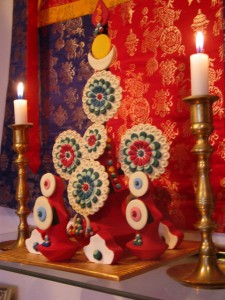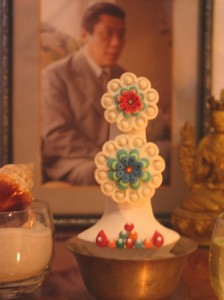Tuesday
Arts and PoetryOn Torma Offering
by Phil Karl
While practicing in the three-year retreat at Gampo Abbey several years ago I learned to make tormas. I’d been making tormas for a number of years, but finally got comprehensive training, and plenty of practice in that rather long retreat.
It may be of interest to know that the Tibetan word torma has two parts. The first syllable, tor, is a verb that means to throw out: tormas made of barley flour, butter and other ingredients are literally placed outside as a gesture of making offering—a gesture of generosity. In an inner sense, the notion of throwing out can be understood as severing attachment to desirable things. That is, cutting through entrapment in desire. It may also be thought of as throwing out kleshas—severance of conditioned emotional reactions that cause suffering. Sincerely offering like this can purify the emotions.
Editor’s Note: We are currently on hiatus from publishing new articles; in the meantime, please enjoy this classic item reprinted from our back issues.
The second syllable, ma, is a feminine ending. It evokes the maternal, a nurturing quality. Understanding the true meaning of this simple syllable is a means of cultivating loving kindness for all beings much as a mother feels love for her children. So, in a way, with the first syllable one severs attachment to self-centeredness. Having cut that, with the second syllable one radiates love and sympathy to others. This is the inner sense of offering torma. As you can see, torma is extremely rich with meaning.
In retreat we learned our torma-making mainly from two teachers, Lama Tashi Thondup and Lama Karma Phuntsok. These lamas were trained at Rumtek monastery in Sikkim, seat of His Holiness the Gyalwang Karmapa, and Sherap Ling, the seat of His Eminence Tai Situ Rinpoche in northern India, respectively. I found that both of these lamas had great precision and skill. (I believe they had been making tormas since they were children.) While their tormas were different from each other, each lama was consistently representing the way he was trained and, it seemed, representing the traits of uniformity and a lack of individual creativity embraced by monastic Tibetans.
This really struck me. Coming from a western tradition of valuing creativity, artistic expression and individuality, I realized that I had some unlearning to do. I had never really questioned the values of individual expression. This was a deeply ingrained outlook. I had difficulty measuring up to the standards of uniformity that came so naturally to these Tibetan guys. Still, I had to make tormas that were… well, correct.
I tried to understand the deeper logic of making offerings and the symbolic meaning of tormas. The tradition is important to preserve even while the tradition undergoes a process of transformation. That seems contradictory, but any time Buddhism moves to a new culture, it morphs: the outer aspects naturally change while the core understanding remains. This is the sign of a living tradition and was a principle that my root teacher, Chogyam Trungpa Rinpoche, always stressed. In my thinking, torma-making became a metaphor for Dharma in the West.
In making tormas, I work with that idea all the time. The basic shapes are often inspired by the Rumtek style of Lama Tashi. The vivid colors and some of the ornaments are closer to Lama Phontsok’s Sherap Ling style. I take a few liberties with some of it, based on what I find appealing, without changing the fundamentals. The result is what you’ll see on my website. Take a look.







Nov 2, 2018
Reply
Many thanks to both Carl and Kristine for sharing your wonderful experience and knowledge.
Dec 26, 2011
Reply
thank you, Lama
Mar 18, 2009
Reply
Thanks for your comments Kristine. Great you’re traveling the world and studying tormas, and the rest of it. Look forward to seeing your pictures and please let me know when you put them up.
I found this great site a while back of the 2007 Nyingma Monlom:
http://www.palyulsg.org/torma_01.htm
Check it out,
Phil
Mar 14, 2009
Reply
At the Rinchen Terdzo that was recently conducted in Orissa, India all the tormas (with only a few exceptions) were done in the Mindroling style. Jamgon Kongtrul had recommended this when he wrote the Rinchen Terdzo as this style had all the possible combination’s of parts (of tormas) that were required to have the representations for over 800 empowerments.
The tormas were made daily with great precision. What I noticed after I learned the differences in the shapes was the areas where individuality was highly encouraged. Some of the jen or butter ornamentation can be quite varied. The best example of this is the ‘long life vase’ the shape will always be the same but the flowers can be a range of colours, shapes and sizes. The various chopons who were working on tormas would jostle for the chance to make another long life torma.
All the chopons for this long empowerment were trained by the same lama and yet there was quite a variety of ‘shape’. they would joke amongst themselves that that was due to their variety in shape! They would also tease each other saying indian style, nepali style and tibetan style. Indian style was not such a great shape but made fast, nepalee style was using a knife to trim things down, tibetan style was doing everything with just your hands. They were all striving for the same sizes and the daily head torma person would ensure that all the tormas were the same hieght at least!
I have studied torma with the two lamas Phil Karl mentions and also Lodro Sangpo at Gampo Abbey, the lamas at Pullahari in Nepal (Rumtek style), Lama Pegyal in Boulder and a little with Lama Ugyen when he taught in Shambhala. I was making a Paltor in the style Lama Ugyen taught us from memory and all the torma boys (all monks) smiled and said that is tibetan style and the same as their teacher made (Lama Tendzin, Parping)
He was trained in Orissa by a lama who knew Lama Ugyen – small world!
We occasionally had guest torma makers from the neighboring nakpa monastery. They had a particular technique that the lama wanted us to learn, applying jen or coloured butterwax to larger areas and some detailed swirls.
It is really amazing that we can carry forward this tradition of generosity and mindfulness and contemplation into our culture. I find that it can be as straight forward as offering a friend a cup of tea when they enter your house and as spiritually moving as meeting your teacher face to face.
I hope to post some examples of the fabulous work in Orissa when i get back.
If you would like to learn more about torma (it is hands on) please ask the shrinekeeper or chopon at your local centre.